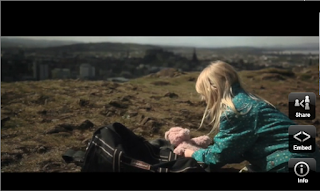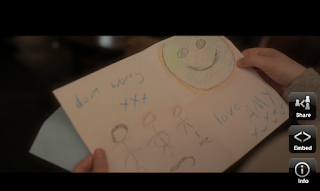Synopsis: A young girl leaves her family for what could be the last time. Where is she going?
The opening shot has a melancholic piano soundtrack automatically setting the mood in the film to be sad. There is also a diegetic sound bridge of a news reporter speaking; connection several shots together (in and around the apartment complex.) The setting is run-down: with dirt and grime on the windows and on the overhangs, the pavement is uneven and tiles have obviously been replaced without much care. The long shots of the setting shows in detail how run down the area is; while the second shot shows the tower block at a very low angle- making the spectator feel small and insignificant. This décor and surrounding setting says that there's been problems that no one has put much care into fixing- which is what the story is about. The sound bridge is that of the news report; telling us of something that has caused panic. We hear "Schools have been closed, homes have been evacuated as cars stay abandoned" telling us how wide spread this panic is, though we don't know what it is that has caused this. This news report is an enigma; we're left wondering and questioning what is happening around the world. This news report shows the disruption to the story's narrative; there is no equilibrium
We get a cut to the inside of an apartment block we see a couple sitting on a sofa watching television, the one that we heard from outside the block- making a sound bridge. There's a dolly movement shot at medium range to show both characters, and their setting, effectively. From the woman's costume it is clear that she is pregnant. The man is comforting the woman, with his body language in a protective stance as his arm is around her. However, both facial expressions show fear over what is shown on the television. The representation here show that both men and women feel fear over the same thing; a positive representation on the equality of gender. In terms of audience, the film would appeal more to the ages shown in the film (early to late 20s) as it hits them the heaviest, especially those with or expecting children. We then get a cutaway to a small girl, the daughter, waving at their parents- the mother halfheartedly waves back. The lack of emotion in this wave suggest a deeper struggle within her; her eye-line is matched with the television and she doesn't change it.This could be a representation of a young mother (aged mid twenties), in a negative light: how she doesn't pay attention to her daughter instead focuses on the television; the same can be said for the father. We're also met with a, as Levi Straus put it, binary opposition between fear and bravery- the parents and the daughter; who's costume shows she's going outside with a backpack to face whatever it is that's out there. In terms of Rick Altman's theory on genre, the news reporter's diegetic dialogue is a semantic code for a science fiction or horror/thriller genre: he's telling us about a disaster that has/will occur; yet we're not told more information leaving us in a restricted narration.
We see the young girl walk through the apartment complex, dragging the bag along with her. We go from an extreme long shot to a medium shot, tilting up to show fully the girl's character: fully showing her costume. We see her wearing a, stereotypical, wooly hat in the design of a koala bear- representing the young ages as animal lovers; a positive representation. We also see her wearing a coat; she obviously hasn't been pestered by her parents to wear one so it's a very positive representation of a child, showing her as a thoughtful person- whilst further enforcing the negative representation of the parents. The backpack could also be seen as a semantic code for adventure, signifying the journey she is going on. At this point she has just gone past her 'Call to Adventure' in Vogler's terms. The extreme long shot that follows signifies her isolation; how she's alone in this adventure- further enforced by the slow paced cuts showing the surrounding, empty, setting.
We then see an empty playground from a birds eye view as the non diegetic soundtrack continues to play; the angle suggests that we are in an omniscient view but we are still in restricted narration; we don't know what will happen next. The lack of other characters in the shot further enforces the feeling of isolation connoting the beginnings of an apocalypse. We cut to an eye-level angle of the girl walking through the park; the playground's frame gives a slitted view giving the impression that we're not only watching her, but also trying to avoid being seen as well. This connoted the feeling that there's people trying to hide from the girl, the 'hero.' So far, most of the semantic codes have defined this short film as a social realism- the playground setting, the apartment complex setting, the homely setting, the soundtrack and the girl's casual costume all help define social realism. However, with the thoughts of the news reporter still embedded in our minds the settings could also show how afraid everyone is; and the codes are there to make the film more relatable for the target audience.

We then cut back to the setting from the beginning. The mother is still facing the television screen; she is fully in focus and her background is not. As she turns her head (presumably because there's a break in the television screening- no diegetic sound can be heard) she begins to go out of focus- focus pulling on the background. The eye-line match lands on a letter labeled "mummy + daddy"; as it is the mother who sees it this stereotypes the 'mothers instinct' used often when children are in films. There's also a slight pick up in the pace of the soundtrack- an action code- signifying the 'hero's journey' is about to reach a climactic situation (crossing the threshold.)
The film then cuts back to the girl who is walking under a bridge where we finally see other characters in the outside world; we have a person running with a trolley cart and another carrying a prop television box- both are semantic with an 'end of the world' genre such as science fiction, thriller or horror. In Vogler's theory this could be the testing of allies and enemies; how two people are running and thieving in the eyes of the apocalypse and then there's another two people, the allies (the girl and the homeless man), facing it with courage and fear respectively. The girl reaches into her pocket and hands the homeless man a lollipop; a simple gesture that has left the audience heart-warmed- making them wish to have their child do simple gestures as shown. We are shown here a representation of the child's mind; how she shows no fear unlike all the other characters and she offers to comfort people where others should. We're also met with the binary opposition of young and older; and two very different representations of both; leaving the old to be the ones under scrutiny from the audience.This gesture is certainly powerful and I'd like to mimic it in our short film in order to make the audience react more to the film. The man's body language- his grip on the handle as well as the slight movement as if gazing at it- shows that he is emotionally changed because of this gesture; something that reflects onto the audience.
As we approach the summit of the hill there's a low angled tilt showing the girl's body language- it shows that she's determined in whatever she's doing. It's also a camera angle that's often used in sports programmes; when a cricketer is walking down the pitch and we get shown his body from toe to head- perhaps foreshadowing a future event. The protagonist then takes her hood off; letting her hair flow free in a very adult-like manner; perhaps, through the entire film, the roles have been reversed and she's the only mature person around and the adults are as immature as their children are.
We're then shown an extreme long shot showing the girl as just a speck compared to the rest of the screen; this is our first glimpse at what might happen. It is a forewarning that there will be an event that includes the hill and the city. As we cut back to the hill we are reminded that the girl is still just a child; as she puts her pink teddy safely in the bag.
We get an eye-line match on the letter that the daughter wrote: it shows her family and what looks like a smiling sun with the words "dont worry love AMY" written like a stereotypical letter from a child would be like. We get a brief understanding of what the disastrous event will be; a meteor crashing to earth. The childlike manner in the letter suggests that Amy doesn't truely understand what's happening; but she still wants to help in any way possible. We cut back to the hill where we are shown a close up of the inside of the bag. We see props used to show a sports bag; a baseball glove and ball- but there's no bat. We know what the girl is now planning. We know it won't work; but we still believe and hope that it will.The quick pan and tilt reveals that we were right and the girl is holding a purple handled baseball bat- we're still shown the representation that she is a child by the colour of the handle when she's the only one who's trying to save the city.
There's a small slow-motion effect as we tilt to her head; then we cut to an extreme long shot (would have been just a long shot if she was adult height); signifying that she is still a child. The small white light- presumably the sun- then erupts in a burst of light. This post production effect shocks the audience, who weren't expecting such a display of colour. We cut away, back to the girl, as she wipes her forehead- an adult mannerism that she is mimicing; the final adult representation of a child. The lighting in these scenes are much brighter compared to the dreary greys in the city; showcasing her heroic actions. This is also were we first meet the antagonist; a binary opposition to the human- nature.
There's another slow motion effect, showing clearly how prepared she is to face the incoming meteor.The soundtrack drops the eerie piano tunes in favour of the guitar strings; making the scene even more dramatic. The meteor is then showed hurtling towards the city; its size immeasurable compared to the girl.
Finally, we see the girl swing the bat- only for a cut to black to occur once we hear the diegetic swinging sound. The title shows; saying "believe"- so we are truly left believing that the protagonists' plan worked- that she saved the city. This dramatic cut leaves the ending up to the audience; though they'd all wish that she survived. This is another thing that most short films have in common; the lack of a new equilibrium- how that is up the viewer. This is something that we'd most likely end up using in our film; how the ending is up the viewer.

































Outstanding work again Stephen! Well done! Exceptional detail, terms, theory and development - and this is consistently applied across your examples. I think you've done enough.
ReplyDelete